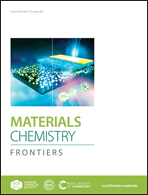BaTiO3-g-GO as an efficient permselective material for lithium–sulfur batteries†
Abstract
Notwithstanding the fact that the unique properties such as high theoretical capacity, energy density, low cost and environmental benignity have helped in identifying Li–S batteries as a potential successor of lithium-ion batteries, the inherently low conductivity of elemental sulfur, shuttling of polysulfide between two electrodes and undesirable interfacial properties of the lithium metal anode with electrolytes impede this system from commercialization. Myriad strategies have been adopted to surmount these challenges such as encapsulation of elemental sulfur in carbonaceous materials to enhance conductivity, introduction of modified separators to mitigate the shuttling of polysulfide etc. In the present work, hybrid nanoparticles, barium titanate–grafted–graphene oxide (BaTiO3-g-GO) was prepared by chemically coupling BaTiO3 to graphene oxide (GO) sheets by a solvothermal method. Additionally, biomass-derived activated carbon (AC) obtained from sisal fibres was also prepared. Trilayer membranes (TLM) were prepared by coating BaTiO3-g-GO and AC on either side of the commercially available Celgard 2320 separator. The Li–S cells with AC/BaTiO3-g-GO-coated trilayer permselective membranes delivered an initial discharge capacity of 1450 mA h g−1 at 0.1C and also appreciably suppressed the self-discharge of Li–S cells even after 40 h which opens up the venue for Li–S batteries to achieve long cycle life without self-discharge for multifarious applications.



 Please wait while we load your content...
Please wait while we load your content...